Binghamton Babylon
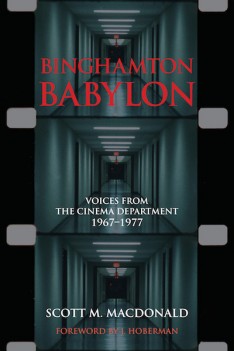
Binghamton Babylon
Binghamton Babylon
With author Scott MacDonald in person
At the Spielberg Theatre at the Egyptian, 6712 Hollywood Blvd, Los Angeles, CA 90028
Filmforum welcomes scholar Scott MacDonald to present a screening of some of the cinematic highlights produced at the State University of New York at Binghamton in the early 1970s, the focus of his latest book.
Binghamton Babylon documents one of the crucial creative adventures in the history of the academic study of cinema. The emergence of a Cinema Department at what was then the State University of New York at Binghamton (now Binghamton University) between 1967 and 1977 brought together a group of faculty and students whose dedication to the study of cinema produced a volatile mix of personalities, a remarkable body of films and videos, and graduates of the program who have invigorated the American media scene for the past half-century. In Binghamton Babylon the Cinema Department is remembered by faculty, students, and visiting artists in a meta-conversation that explores the academic excitement of the moment when cinema became a viable academic subject in colleges and universities across the country.
The Cinema Department assembled a cadre of gifted teachers—Larry Gottheim and Ken Jacobs, video-art pioneer, Ralph Hocking; and Hollywood legend Nicholas Ray (Rebel without a Cause) and hosted visiting filmmakers (Ernie Gehr, Peter Kubelka, Hollis Frampton, Morgan Fisher, Saul Levine…)—who worked to nurture several generations of remarkable students, including film critic J. Hoberman, cultural critic Camille Paglia; dancers Arnie Zane and Bill T. Jones, who founded the American Dance Asylum while in Binghamton; Daile Kaplan (the photography expert for PBS’s Antiques Roadshow); fledgling filmmakers Phil Solomon, Alan Berliner, and Daniel Eisenberg; and soon-to-be accomplished programmers Steve Anker and Richard Herskowitz. – Scott MacDonald
Tickets: $10 general admission; $6 students (with ID)/seniors; free for Filmforum members.
Tickets available at http://binghamtonbabylon.bpt.me or at the door
For more event information: 323-377-7238
Scott MacDonald is author of the series, A Critical Cinema: Interviews with Independent Filmmakers, in five volumes from University of California Press, and ten other books, most recently, American Ethnographic Film and Personal Documentary: The Cambridge Turn (California, 2013), Avant-Doc: Intersections of Documentary and Avant-Garde Cinema (Oxford, 2014), and Binghamton Babylon: Voices from the Cinema Department (a nonfiction novel) (SUNY Press, 2015). He was an Anthology Film Archives Film Preservation Honoree in 1999 and was named an Academy Scholar by the Academy of Motion Picture Arts and Sciences in 2012. He teaches film history at Hamilton College.
---------------------------
This program is supported by the Los Angeles County Board of Supervisors through the Los Angeles County Arts Commission; the Department of Cultural Affairs, City of Los Angeles; and Bloomberg Philanthropies. We also depend on our members, ticket buyers, and individual donors.
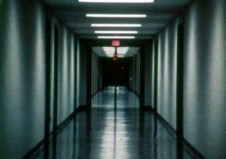
Serene Velocity, by Ernie Gehr
Serene Velocity, by Ernie Gehr
1970, 16mm, 18 fps, color, silent, 23 min.
The first film shot (in a Binghamton University hallway) under the auspices of the new Cinema Department, and one of the classics of “structural film. -- Scott MacDonald
"A literal 'Shock Corridor' wherein Gehr creates a stunning head-on motion by systematically shifting focal lengths on a static zoom lens as it stares down the center of an empty, modernistic hallway. Without ever having to move the camera, Gehr turns the fluorescent geometry of his institutional corridor into a sort of piston-powered mandala. If Giotto had made action films, they would have been these." - J. Hoberman, The Village Voice
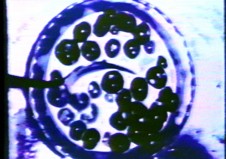
Blues, by Larry Gottheim
Blues, by Larry Gottheim
1970, 16mm, color, 8 min.
In 1970 Gottheim rebooted his career in order to explore the fundamental elements of cinema, with this lovely single-shot meditation.
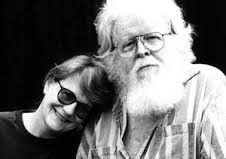
The Experiment, by Ralph Hocking
The Experiment, by Ralph Hocking
video, 10 min.
The Experimental Television Center (ETC) was founded in 1971 by Ralph Hocking. The center was the result of the expansion of a media access program that Ralph Hocking established as Professor of video and computer art at Binghamton University in 1969. This is the first videotape that Hocking decided to keep, a dive into the performative immediacy of the then-new video technology and its potential to create new senses of time.
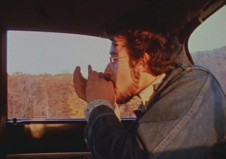
Harmonica, by Larry Gottheim
Harmonica, by Larry Gottheim
1971, 16mm, color, 10.5 min.
With Shelley Berde.
Gottheim’s first sound film. A paean to creative learning and an evocation of the Aeolian Harp, beloved of the Romantic poets.
“O! the one Life within us and abroad, Which meets all motion and becomes its soul, A light in sound, a sound-like power in light, Rhythm is all thought, and joyance everywhere -- Methinks, it should have been impossible Not to love all things in a world so fill'd; Where the breeze warbles, and the mute still air is Music slumbering on her instrument. And what if all animated nature Be but organic Harps diversely fram'd That tremble into thought, as o'er them sweeps Plastic and vast, one intellectual breeze, At once the Soul of Each, and Good of all?” -- S. T. Coleridge, The Eolian Harp
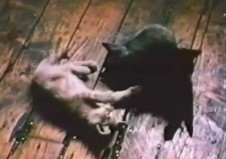
Nissan Ariana Window, by Ken Jacobs
Nissan Ariana Window, by Ken Jacobs
1969, DVD from 16mm, color, 14 min.
One of the few films the prolific Jacobs made during his early years in the Binghamton Cinema Department—when shown with Sergei Parajanov’s Shadows of Forgotten Ancestors at an on-campus public event, it had long-term reverberations.
“NISSAN ARIANA WINDOW is 3/4's of our daughter's name. She was just kid when these pictures were taken. Some were taken before she was born: pregnant Flo together with pregnant cat China sunning themselves under the skylight. Andrew Noren likes the movie.” --K. J.
Scrambled Legs, by Ralph Hocking
(Video, 3 min.)
Hocking’s earliest completed experiment with video switching—a video nod to the tradition of the classic nude (and Sherry Miller Hocking’s legs).
Patent Pending, by Alan Berliner
1975, 16mm, b&w, 11 min.
A student film by a fledgling master—a single-shot “research report” on Berliner’s experiences as the Harpur College Film Society projectionist.
Nightlight, by Phil Solomon
1975, 16mm, b&w, 8 min.
Another student film by another fledging master, Solomon’s first attempt at a cine-nocturne.
"My senior thesis at Binghamton, a first, minimal exploration of the Bolex single-frame "T" setting (open shutter/ longer exposures) during my nocturnal walks around Johnson City, N.Y. Inspired by the night and day ambiguities of Brakhage's Fire of Waters, Nightlight eventually gave rise to a series of Nocturnes." – Phil Solomon
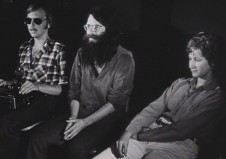
Before the Fact, by Bill Brand
Before the Fact, by Bill Brand
1974, 16mm, color, silent, 6 min.
On Bill Brand’s visit to campus one summer, he recorded an experiment in sound with faculty member Saul Levine and two Binghamton students.
“Made at S.U.N.Y. at Binghamton as a class exercise, filmmaker Saul Levine performs with students who each try to mimic his previously recorded phrase and then try to imitate each other imitating the recording.” – Bill Brand
Blue, by Peer Bode
1975, video, 3 min.
Video artist Bode’s video homage to Larry Gottheim
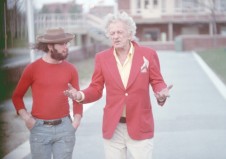
Opening of We Can’t Go Home Again by Nicholas Ray
Opening of We Can’t Go Home Again by Nicholas Ray
1973, color, sound, 7 min. excerpt
As soon as Hollywood great Nick Ray joined the Binghamton faculty, he transformed his students into a production unit and began to experiment with them and himself.
“During the contraction of Hollywood movie production in the nineteen-sixties that resulted from the rise of television and decline of the studios, many great filmmakers dropped out of the business or were pushed to the margins. One was Nicholas Ray—among the very greatest American filmmakers. When Ray surfaced again, at Harpur College (now SUNY Binghamton), in 1971, he worked with his students on a movie, “We Can’t Go Home Again,” that differed radically from his earlier films. Since he wasn’t in Hollywood and wasn’t working with a cast or crew from the studios, he didn’t work as directors do there. Rather, he developed an advanced and complex cinematic form to match his personal situation and the troubled times. Putting film images through a video processor, he condensed multiple shots into individual frames; he used multiple exposures, color transformations, shape distortions, and geometric overlays to capture a sense of a mind and a world in turmoil—of a filmmaker and a generation in crisis. Needless to say, “We Can’t Go Home Again” didn’t receive a wide commercial release, or even a limited one. The film screened at the Cannes Film Festival in 1973 but wasn’t picked up for distribution. Ray shot more footage, tinkered with it for a few more years, and then moved on.” – Richard Brody, The New Yorker, http://www.newyorker.com/culture/richard-brody/dvd-of-the-week-we-cant-go-home-again
